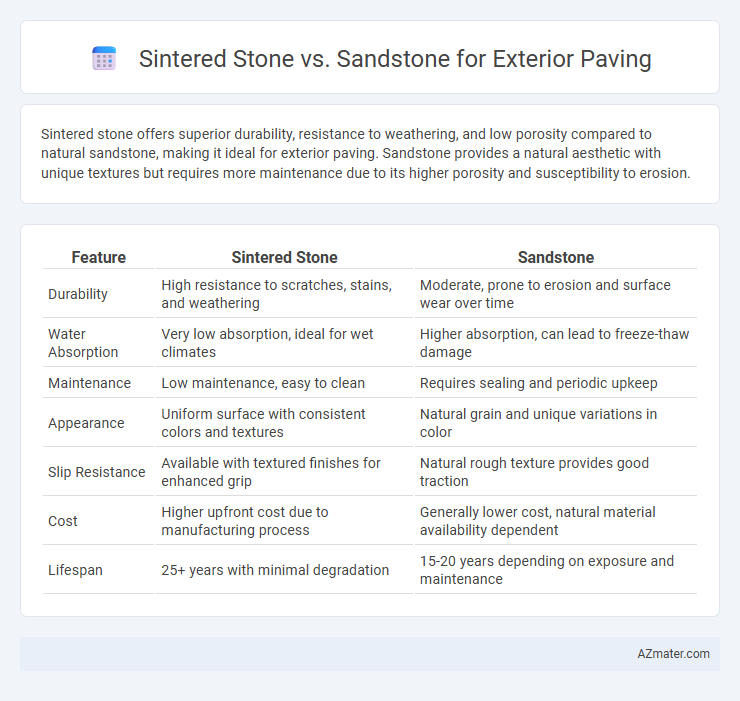Sintered stone offers superior durability, resistance to weathering, and low porosity compared to natural sandstone, making it ideal for exterior paving. Sandstone provides a natural aesthetic with unique textures but requires more maintenance due to its higher porosity and susceptibility to erosion.
Table of Comparison
| Feature | Sintered Stone | Sandstone |
|---|---|---|
| Durability | High resistance to scratches, stains, and weathering | Moderate, prone to erosion and surface wear over time |
| Water Absorption | Very low absorption, ideal for wet climates | Higher absorption, can lead to freeze-thaw damage |
| Maintenance | Low maintenance, easy to clean | Requires sealing and periodic upkeep |
| Appearance | Uniform surface with consistent colors and textures | Natural grain and unique variations in color |
| Slip Resistance | Available with textured finishes for enhanced grip | Natural rough texture provides good traction |
| Cost | Higher upfront cost due to manufacturing process | Generally lower cost, natural material availability dependent |
| Lifespan | 25+ years with minimal degradation | 15-20 years depending on exposure and maintenance |
Introduction to Sintered Stone and Sandstone
Sintered stone is an engineered material created through the fusion of natural minerals under high pressure and temperature, resulting in a durable, non-porous surface ideal for exterior paving. Sandstone, a natural sedimentary rock composed mainly of quartz and feldspar, offers a traditional aesthetic with its porous texture and warm tones but requires more maintenance due to its susceptibility to weathering. Both materials provide distinct advantages for exterior paving, with sintered stone excelling in durability and stain resistance, while sandstone offers natural beauty and a more rustic appeal.
Composition and Manufacturing Process
Sintered stone is engineered from a blend of natural minerals and pigments compressed under extreme heat and pressure, resulting in a dense, non-porous surface ideal for exterior paving. Sandstone is a natural sedimentary rock composed mainly of sand-sized mineral particles cemented by silica, calcium carbonate, or iron oxides, formed through geological processes over millions of years. The manufacturing process of sintered stone involves advanced technology that enhances durability and resistance, while sandstone requires quarrying and cutting, with variable porosity and weathering properties impacting its long-term performance outdoors.
Aesthetic Appeal and Design Options
Sintered stone offers a sleek, uniform appearance with a wide range of colors and patterns that mimic natural stone, enhancing modern aesthetic appeal for exterior paving. Sandstone provides a warm, earthy texture with natural variations and rustic charm, ideal for traditional or organic design schemes. Both materials support diverse design options, but sintered stone excels in durability and color consistency, while sandstone offers unique, tactile character.
Durability and Weather Resistance
Sintered stone exhibits superior durability and weather resistance compared to sandstone, making it ideal for exterior paving in harsh climates. Engineered through high-pressure and high-temperature processes, sintered stone resists UV rays, freezing temperatures, and heavy rainfall without fading or cracking. Sandstone, although naturally attractive, tends to be more porous and vulnerable to erosion, frost damage, and surface wear over time.
Slip Resistance and Safety Features
Sintered stone offers superior slip resistance compared to sandstone due to its non-porous surface and advanced manufacturing process, which enhances traction even when wet. Sandstone, while natural and textured, can become slippery over time as its surface wears and accumulates moss or algae. For exterior paving applications requiring maximum safety, sintered stone's durability and consistent grip reduce the risk of slips and falls, making it a preferred choice for high-traffic outdoor areas.
Maintenance Requirements and Longevity
Sintered stone offers superior durability and minimal maintenance compared to sandstone, resisting stains, scratches, and weathering without the need for frequent sealing or specialized cleaning products. Sandstone, while aesthetically pleasing with its natural textures, requires regular sealing and careful maintenance to prevent erosion, staining, and moss growth, especially in outdoor environments. The longevity of sintered stone surpasses sandstone due to its engineered composition, making it a cost-effective solution for long-term exterior paving installations.
Environmental Impact and Sustainability
Sintered stone offers a lower environmental impact than sandstone due to its manufacturing process, which uses natural minerals fused under high pressure without chemical additives, resulting in minimal waste and higher durability. Sandstone, as a natural sedimentary rock, requires extensive quarrying that disrupts ecosystems and generates significant dust and runoff, contributing to habitat loss and soil erosion. Choosing sintered stone for exterior paving enhances sustainability by providing a long-lasting, recyclable surface that reduces resource depletion and environmental degradation over time.
Installation Process and Costs
Sintered stone offers a streamlined installation process due to its lightweight and uniform thickness, reducing labor time and overall costs compared to sandstone, which requires more intensive groundwork because of its natural variability and heavier slabs. The precision-cut nature of sintered stone minimizes the need for additional substrate preparation, lowering material waste and installation expenses. While sandstone involves skilled labor for proper fitting and may incur higher maintenance costs, sintered stone's durability and easier handling translate to a more cost-effective choice for exterior paving projects.
Applications in Exterior Paving
Sintered stone offers superior durability, resistance to frost, stains, and UV rays, making it ideal for high-traffic exterior paving areas such as patios, walkways, and pool surrounds. Sandstone, valued for its natural textured surface and aesthetic warmth, is commonly used in garden paths and driveways but requires regular sealing to prevent erosion and color fading. Both materials are chosen for their slip resistance and ability to withstand outdoor weather conditions, but sintered stone generally demands less maintenance and offers greater longevity in exterior paving applications.
Choosing the Right Material for Your Project
Sintered stone offers superior durability, stain resistance, and low maintenance properties compared to traditional sandstone, making it ideal for high-traffic exterior paving projects. Sandstone provides natural beauty and texture but requires regular sealing and is more prone to weathering and erosion over time. Selecting sintered stone ensures long-term performance and aesthetic consistency, while sandstone suits projects emphasizing rustic charm and natural variation.

Infographic: Sintered stone vs Sandstone for Exterior Paving
 azmater.com
azmater.com